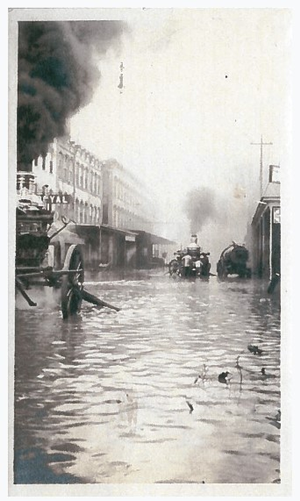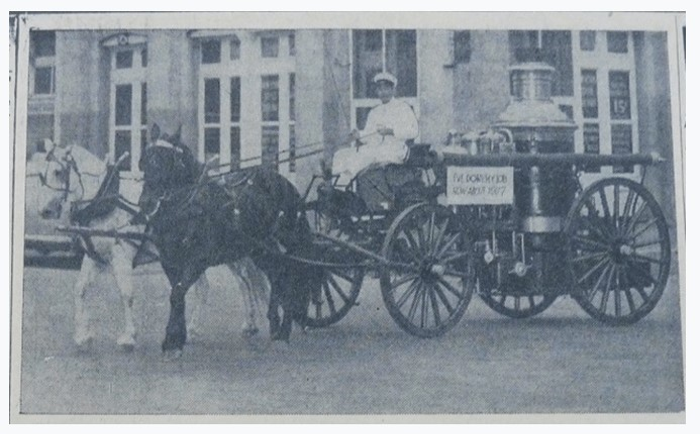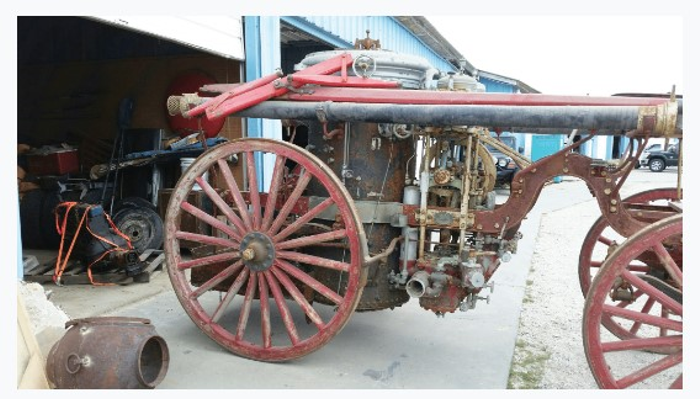This feature originally ran in the May 2016 issue of Galveston Monthly.
Galveston Island is rich with history — The
Strand, the 1892 Bishop’s Palace, hundreds of examples of meticulously restored
Victorian architecture — and one relic that has been all but lost to the sands
of time. An authentic horse-drawn American LaFrance Metropolitan steam fire engine that served
Galveston for almost a half century is the latest addition to the Galveston
County Museum’s growing collection of artifacts.
 Considered at the
time to be the epitome of late-18th century firefighting technology,
the roots of American LaFrance, one of the oldest and
most storied names in fire trucks, can be traced back more than 180 years.
Considered at the
time to be the epitome of late-18th century firefighting technology,
the roots of American LaFrance, one of the oldest and
most storied names in fire trucks, can be traced back more than 180 years.
“I was so excited. I could not believe such an amazing
artifact was intact and still in Galveston,” says Jennifer
Wycoff, director-curator of the Galveston
County Museum.
“The old steamer is still in very good condition, considering all the events it
has been through. It does need clean up and some restoration, in particularly
in some of the lower metal components. The wheels and wood are in fantastic
condition and still have the original red and gold paint detailing on them.”
Before restoration work begins, the public will have a chance to view
the steam pumper at the old Galveston County Courthouse, the new
home of the Galveston
County Museum.
The steam pumper, which is owned by the Galveston Professional
Firefighters Association Local 571, might never have made it to the museum had
it not been for the curiosity of historian and author Melanie Wiggins.
Wiggins, who is also a member of the Galveston County Historical Commission and the
Texas Gulf Historical Society, first learned of
the steam pumper several years ago while doing research for her book entitled Torpedoes in the
Gulf: Galveston
and the U-Boats, 1942-1943.
During World War II, the antique steel, copper, and brass steam pumper
was nearly melted down as part of the “harvesting a bumper crop for Uncle Sam”
scrap metal drive effort to build airplanes, tanks, and weapons, Wiggins says.
 “But it was spared, thanks to public outcry,” Wiggins says. “Like Galveston itself, the steam pumper survived hurricanes,
floods, and even war, and now it will have a permanent home in the new Galveston County Museum,
which is just wonderful.”
“But it was spared, thanks to public outcry,” Wiggins says. “Like Galveston itself, the steam pumper survived hurricanes,
floods, and even war, and now it will have a permanent home in the new Galveston County Museum,
which is just wonderful.”
At the time when she first learned of it, Wiggins discovered that the
steam pumper was on display at The Galveston Railroad Museum, and she went to
see it.
“I
was amazed to see the real thing: large, ponderous, red, and with a big black
water tank and steam chimney. An impressive machine.”
In 2008, Hurricane Ike slammed into Galveston and flooded the museum with eight
feet of water — but the steam engine was spared. The museum closed for
repairs, and the
steam pumper was moved to Galveston Fire Station 1 which serves the downtown
area including the Strand Historic District and the central portion of the Port of Galveston.
Last year,
the firefighter’s union began talks with the Fire Museum of Texas in Beaumont to
find the antique a permanent home, and the steam pumper was temporarily moved
to a storage unit on the west end of the island that belonged to
firefighter Joshua Norregaard.
When Wiggins began research on her current project on Galveston fires, that’s where she found
it — and she sent up a smoke signal to Wycoff.
“I just thought she should know because we needed to find a way to keep
this Galveston
treasure on the island,” Wiggins says. “Jennifer was as excited as I was, as we
knew that it would be a major addition to the collection and fun for all to
see, as well as offering the local firemen a chance to participate in its
history.”
Within minutes of Wiggins’ call, Wycoff received a call from Galveston
Fire Department Captain Gregg Riley, who wanted to discuss the potential for
using the steam engine as a feature for a museum exhibit. Wycoff was thrilled.
On February 11, the museum curator got her first look at the horse-drawn
steam pumper, “and it was love at first sight. I asked them how I could acquire
the artifact for the Galveston
County Museum
and protect it in perpetuity.”
Wycoff says Riley instructed her to write a proposal and plans for the
artifact on behalf of the museum, and “he promised to arrange a meeting of the
Fireman’s Union and present the idea.” He
followed through on that promise.
“We quickly and unanimously voted to keep the steamer on the island,
where it belongs,” Riley says. “The Galveston Professional Firefighters
Association Local 571 owns the steamer, and we are partnered with the Galveston County Historical
Commission to allow them to restore and display
the steamer for 30 years, which I believe was the term.”
 The steamer will require a major facelift, as well as structural repair
in the boiler mechanism, and some fabrication of a new brass cap on the boiler
box, he says. The restoration will be funded by donations and grants.
The steamer will require a major facelift, as well as structural repair
in the boiler mechanism, and some fabrication of a new brass cap on the boiler
box, he says. The restoration will be funded by donations and grants.
But the first step was to move
the steam fire wagon, which is not operational, from the storage unit to a
county facility.
“I
was very concerned about moving the 8,000-pound steamer, with had no immediate
funds at hand, so I proceeded to contact our county fleet director, Mike Tubbs,
who suggested Marty’s Towing LLC and promised he would assist in pleading the
cause,” she says. “Marty’s specializes in the moving of antiquities, and they
honorably agreed to donate the transportation of the fire steamer to the county
facilities.”
On March 2, Wycoff arrived at Norregaard’s storage unit, and a crowd began to
form as the mammoth machine was rolled out of the unit.
“First one man appeared, then a second, then a third, fourth, fifth,
sixth, and so on, until there was a large crowd of men circling the fire
steamer in awe of what they saw,” Wycoff says. “Many of these good men gave me
their business cards and offered to assist in restoration of the artifact, as
they were also truly amazed at its rarity.”
Wycoff says the county is accepting donations toward the restoration
effort. The idea, she says, is to keep the antique looking like just that—an
antique.
“For restoration donations, people would contact me here at the museum
and all funds would go into an earmarked account within the Galveston County
Historic Commission, for the restoration process,” Wycoff says.
“In speaking with the Galveston County Historic Commission, everyone
seems to feel the same as I do about keeping it as close to its original state
as possible, although conserve it—replace brass, stop as much rust as possible
and re-stain red colors, without using harsh paints.”
Captain Riley says he wants museum visitors to see what he sees when he
looks at the steam pumper—a glimpse of Galveston
past. “For me, looking at it makes me imagine what it must have been like to be
in downtown Galveston in the early 1900s, with
horses everywhere, wooden streets, high curbs, cotton bales, the smell of horse
manure and coffee roasters and just the major hustle and bustle that Galveston was during that
time.”
By today’s standards, the horse-drawn apparatus seems ill-equipped to
fight a raging inferno. But it was leaps and bounds better than what had come
before it. Riley confirms that this machine was state-of-the-art.
“It resembles a large wagon like apparatus, with an iron frame, a
two-person seat up front, and long wooden yoke. The large brass dome on top of
the boiler sets off the steamer in great style,” Riley says.
“The back of the steamer features a small ledge for the fireman—literal
in this sense—to ride next to the coal tray. A fire had to be started in just a
few minutes while underway and then it had to be hot enough to add coal to get
the boiler producing a head of steam, which drove the pistons that turned the
water pump. I could imagine what one of these sounded like while it was
pumping. The wheels are very tall, made of (I would guess) cypress, and steel
rimmed. Certainly, an American LaFrance Metropolitan steamer was the cutting
edge of equipment in those days.”
When the era of the horse-drawn steam fire
engine ended, some of the horses used to pull the steam pumper went on to pull
milk wagons. “There are stories of old fire horses hearing the bells clang and
taking off toward the fire, shattering all the glass milk bottles as it ran,”
Riley says. “That must have been a real sight. Once a fireman, always a
fireman.”
Norregaard says knowing that the museum will give it a forever home, “is
exactly what we’d hoped for. Just being able to keep it from leaving the island
is a really cool. It’s a piece of history, and now it gets to stay here,” Norregaard says.
“Being a small part in making that happen is a nice feeling.”
Riley agrees. “This was the best move for the steamer, as it takes real
resources and space to accomplish the restoration and the museum is the perfect
for it to be seen by the most number of people,” he says.
“I keep thinking of how things that were practical in the past are still
held in tradition today. An old captain pointed out to me that we are only
three generations removed from horses. His captain, while he was a rookie,
always urged him to ‘get it while it’s hot’ when it came to chores or any task.
Come to find out, when that old head was a rookie, his captain at the time came
in the job when horses were still in use, and the best time to scoop the manure
was when it was still hot. We have the ramp in front of firehouses today
because the horses needed a little head start to get going. The firemen had to
push the apparatus back into the station up that same ramp though, and I could
imagine that would be a job. The fire pole and spiral staircases were to keep
the horses from climbing the stairs to the living quarters.”
The more things change, he says, “the more things stay the same.”